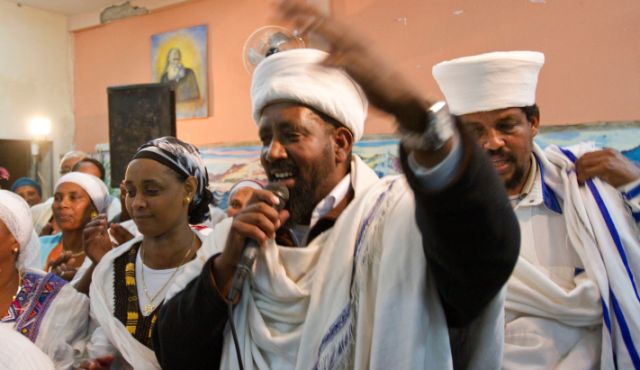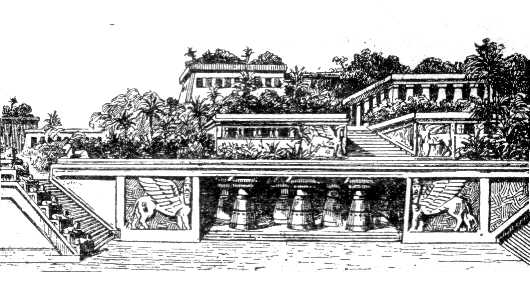- Jan 25, 2009
- 19,769
- 1,429
- Faith
- Oriental Orthodox
- Marital Status
- Private
- Politics
- US-Others
Good thoughts...and I definitely agreeGod is going to have a great stew, full of robust flavor, each embodying the aspects that are their own but reflect what God intended. Music, clothing, traditions, habits, food, architectural nuances are all part of the freedom of expression God allows within His kingdom. I picture His world to come, not to harmoniously bland to one culture but to each as unique as the galaxies, world, stars of His universe. The only requirement is obedience to His commands. .
If I may say.....Is the Messianic movement merely a subculture, product, of the West ?
Does it reflect the Way of the ancient heroes, prophets, sages of the Bible and ancient Israel (in the same sense Hinduism currently reflects the ancient Hindu way and Islam reflects the ancient Islamic way) ?
As an example, Tehillim/Psalms being the largest book of the Bible, one would expect music to be an important part of worship. Exodus and the other books of the Torah being concerned with how people shall dress, eat, etc. one would expect that these "superficial" or external things would have value, yet they are almost impossible for the modern man to even visualize, as is evident in the amateurish quality of most "Jesus movies."
[FONT=HelveticaNeue, Helvetica Neue, Helvetica, Arial, Lucida Grande, sans-serif]I feel like most Messianics and for that matter most people making "Hebrew music", "Hebrew art" etc. have some kind of agenda rather than being historical reconstructionists, so it may well be that this culture is lost forever, musically, artistically, architecturally and otherwise. And these things have value, don't you agee? [/FONT]
How can a culture be said to be living, if it is not expressed in mediums such as these?
It seems the Messianic movement is just another Western (and hence Greek-Roman-Catholic-German-American) subculture rather than having anything truly to do with the Maccabees, Israelites or pre-exilic Jews.
As opposed to the contra- or anti-Hellenic Maccabees, and the simply non-Hellenic ancient Israelites, the modern Messianic/Nazarene/etc. seems to be part of the Western, and hence (ultimately) the Greco-Roman culture, which is saddening.
I don't hate jeans, MP3's, etc (and the latter at least might perhaps be called a technological rather than cultural thing, but I would have to look further into that before commenting) but I would like to invoke my examples of the Hindus and Muslims again, who are clearly distinguishable, (albeit still using modern technology,) whereas Messianics generally do not wear Tzitzit or have any other of the signs that set them apart and which in the past set Israel apart from Egypt and Greece.
The Hindus and Muslims have distinct architecture for that matter, but Messianics do not as far as I know - though they may insist that some slight variation on typical Western architecture makes them distinct.
Hence, for example, the commandment regarding roof parapets is seldom needed. Hence an obviation of the commandment in Debarim 22:8 (though not a breaking of it) and it is as though it were never spoken. Generally though I have been referring to the architecture of religious buildings when using the term architecture.
I am NOT saying it is a sin to dress in jeans, but is it not notable that the ancient Israelite way is almost entirely internal at this point, with the external aspects most similar to it being considered basically Muslim ?
.
I think it'd be helpful if there'd be a sharing of resources (i.e. books, websites, journals, etc.) that you may have utilized in order to come to your conclusions so as to ensure all can be on the same page as best as possible. Do you have any off hand you could suggest so that others (myself included) can see what you came across to see as you see things? I'd appreciate it
Perhaps even some pictures included -may be helpful as it concerns showing what the actual dress of Israelite culture looked like so there's more of an image/standard to go by which modern culture is being evaluated by.
With regards to the OP, I think it's definitely an interesting topic to cover - and yet I do think there need to be some things clearly established before going further into the issue of culture and dress.
For if being completely accurate, there's no true way of knowing EVERY style of dress that the Hebrew people had over a thousand year timeframe - or even what was fully done in the time of the beginning of the Hebrew people when it came to Jacob...and prior to that, Isaac and Abraham. They came from Semitic backgrounds and there was never a dress style given to them that the Lord commanded for them to have - the culture of the 12 sons of Israel would naturally be reflective of the Semitic backgrounds they came from, as well as the Canaanite cultures they often interacted with.
And when it came to the Hebrews living for a couple of centuries in Egypt due to the actions of Joseph (who lived amongst the Egyptians/married an Egyptian wife and had sons as well - with the Egyptian dress being a part of him per Genesis 41:41-43 ), there's the reality that Egyptian culture/dress also got involved in the culture of the Hebrew people - and in addition to that, we also have Moses who was involved in Midianite culture (as a shepherd) and brought what he had into the mix.
When I read the Torah on Genesis and Exodus (or Numbers), I don't really see where the Lord at any point said that Israel would be distinguished by its dress style alone - the dress style in the culture was varied and continued to vary as time went on. From the Monarchy beginning with King Saul (in competition with the other kings of the Canaanite cultures) to King Solomon's era with his riches (and dress style per 1 Kings 10:4-6 ), the time of the Babylonian captivity to that of the time in the Persian Empire with Queen Esther (in the dress she had)/the Iranian Jews...the dress styles of different cultures would naturally overflow into the Hebrew culture which never had a set dress code outside of what God commanded the priesthood to wear before Him with the robes/vestments.
Middle Eastern/Near-Eastern culture is where the Israelites developed in - and of course, one could argue that it seems others today are not distinct in being recognized as other cultures connected with Middle-Eastern culture (as with Muslims) - but that even Muslim culture developed in architechture after stealing it from the Arabic Christians/Eastern Christians, reverse-engineering what they saw and then having all other preceeding generations assume that it was a "Muslim" innovation to have the buildings they turned into mosques be as they are. The architecture of the earliest minarets, which are square rather than round, unmistakably derive from the church towers of Byzantine Syria (and several other things that Muslims have a part of their culture already came from Eastern Christians/Jewish believers - as noted before.
Professor Philip Jenkiins Philip Jenkins noted it in-depth in his work entitled "The Lost History of Christianity: The Thousand-Year Golden Age of the Church in the Middle East, Africa, and Asia — and How It Died"It was very brilliant in discussing the many experiences of believers, whether Jewish or Non-Jewish, who literally spread around the world with the Gospel of Messiah---and yet experienced many pains/difficulties despite the victories they had. Some of the largest Christian denominations during the much of European Middle Ages were what the Roman and Greek churches called Monophysites and Nestorians. Especially this last movement, better known as the Church of the East, was a far reaching web reaching as far as Tibet and China. Along with the Eastern Orthodox Church, the Asian and African members of now almost forgotten churches dominated the Middle East in the centuries before the Muslim conquest and then provided most of the architectural, administrative, and scholarly backbone for the Arabic Empire....but when the sect of Islam began to rise in geographical locations, they took over and claimed the buildings made for themselves.
For reference:
In the same way, with Israelite culture, there are many things within it (from Temple style to art as noted in the thread "What did ancient Israelite/Hebrew Art look like?...to dress or hair styles, as discussed before) that were taken naturally from the cultures around them and it was something that became a part of the culture....it wasn't demanded that Israelites had to dress a certain way in order to be distinguished as Israel, outside of scriptural commands such as Deut 22:5 with not dressing in manner as to have men identify as women and vice-versa.
And with Messianic Jews today (or Jewish people who aren't believers), this has also been brought up in differing ways when it comes to noting how God never said that being Israel meant one had to dress in the manner that they did in B.C era - following the Lord was about lifestyle/worship rather than dress alone....the religion of monotheism/following the Lord transcended dress. Even the Maccabees themselves were influenced by/utilized Hellenism surrounding them in order to combat the idolatry around them - and they certainly would not have fit into the mold many have today of "Anything Western = Not being Distinctly Israel".....
I pray what I am saying makes sense....IMHO, I really don't see where it was ever an issue with the Lord for Messianic Jews or Messianic Gentiles to adopt styles of dress from the cultures around them as if that would make them no longer distinct as Israel. And technically, if you nor I dress in the same manner as others in Semitic backgrounds ...and others in Semitic cultures don't all dress stereotypically in Semitic clothing all the time since even they dress in Western styles...then I think we'd have other concerns to deal with.
Many have noted that Messianic Jews in the West would be doing dress-up if they tried to recreate the dress styles of all others they saw in Ancient culture as if that dress style was somehow inherently pure or distinctive - and some Messianics have taken a lot of heat for it, one of them being another who was mentioned before as seen here on Michael Rood:
Originally Posted by bryteguy
He talks about this Biblical Garments. Basically says that: First, let me make the distinction that I do not mow the lawn in my ancient Biblical garments. I dress in typical Israelite garb of the first century in order to help people make a 2000 year mental leap, back to the land, the language, and the culture in which the first century Jewish followers of the Messiah lived.
Easy G (G²);57474792 said:As it concerns his dress:

It does seem to be a bit on the wild side .But honestly, what can be "wild" for one person may not be as "wild" as it'd be for another.......for some people think its wild to dress in 2011 the same way as others did in the 70's, even as dress styles from that era are coming back into being mainstream again. John the Baptist came in Came's clothing ( Matthew 3:3-5 / Matthew 3 , Mark 1:5-7 )---and Isaiah walked around naked by the Lord's command ( Isaiah 20:1-3 / Isaiah 20 ). And with both instances, there was a clear dynamic of the prophetic involved......as the clothing served as a means to an end.Gxg (G²);62150610 said:He used to be with "The Way International" - well known for their cult status and other things they've done...and he still works with people from there. (more shared here , here, here and here). ..International. He has shared his own testimony of his background - although some of the things shared seemed to be a good bit out there when seeing current actions:
Last edited:
Upvote
0






